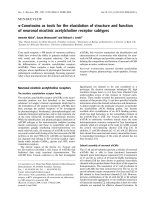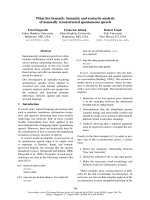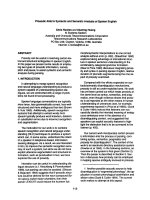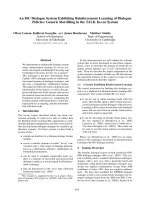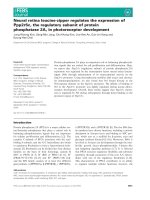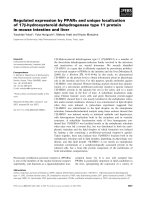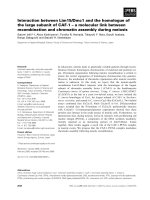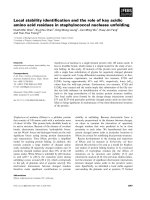Báo cáo khoa học: Local stability identification and the role of key acidic amino acid residues in staphylococcal nuclease unfolding ppt
Bạn đang xem bản rút gọn của tài liệu. Xem và tải ngay bản đầy đủ của tài liệu tại đây (202.78 KB, 8 trang )
Local stability identification and the role of key acidic
amino acid residues in staphylococcal nuclease unfolding
Hueih-Min Chen
1
, Siu-Chiu Chan
1
, King-Wong Leung
1
, Jiun-Ming Wu
1
, Huey-Jen Fang
1
and Tian-Yow Tsong
2,3
1 Institute of BioAgricultural Sciences, Academia Sinica, Taipei, Taiwan
2 Institute of Physics, Academia Sinica, Taipei, Taiwan
3 Department of Biochemistry, University of Minnesota College of Biological Sciences, St. Paul, MN, USA
Staphylococcal nuclease (SNase) is a globular protein
that consists of 149 amino acids with a molecular mass
of about 16 kDa. This protein lacks disulfide bonds in
its native structure. Because of the absence of covalent
bonds, electrostatic interactions, hydrophobic forces,
van der Waals’ forces and hydrogen bonds are the only
significant forces acting during protein denaturation
and renaturation. Thus SNase provides a simplified
model for studying protein folding. In addition, this
protein contains a large number of charged amino
acids, including 20 negatively charged residues and 32
positively charged residues (more than 35% of the 149
amino acids). When SNase is unfolded by pH titration
in acid (pH 7 to pH 2), the transition point during
unfolding occurs around pH 4 [1], which corresponds
to the pK
a
of glutamic acid or aspartic acid [2]. The
electrostatic interactions between charged residues
therefore make significant contributions to protein
stability in unfolding. Because electrostatic force is
inversely proportional to the distance between charges,
we chose to examine the interaction of oppositely
charged residues that were predicted to be in close
proximity to each other. We hypothesized that only
certain charged amino acids at particular locations in
SNase are critical for stabilizing local protein structure.
Recent developments in the cloning and expression
of SNase and its mutants in Escherichia coli have
allowed this protein to be used as a model for biophys-
ical studies of protein folding kinetics [1–3], rotational
mobility of tryptophan residues [4], the effects of
mutations on its structure and stability [5–7] and
calorimetric analysis [6–8]. Our previous studies indica-
ted the presence of significant electrostatic interactions
between charged amino acids in the protein’s native
state. Specifically, we identified a local stable segment
surrounding the glutamic acid at position 75 formed
Keywords
staphylococcal nuclease; local stability; key
acidic amino acid; unfolding
Correspondence
H M. Chen, Institute of BioAgricultural
Sciences Academia Sinica, Taipei, Taiwan
Fax: +886 2 2788 8401
Tel: +886 2 2785 5696 extn 8030
E-mail:
(Received 3 May 2005, revised 3 June
2005, accepted 13 June 2005)
doi:10.1111/j.1742-4658.2005.04816.x
Staphylococcal nuclease is a single domain protein with 149 amino acids. It
has no disulfide bonds, which makes it a simple model for the study of pro-
tein folding. In this study, 20 mutants of this protein were generated each
with a single base substitution of glycine for negatively charged glutamic
acid or aspartic acid. Using differential scanning microcalorimetry in ther-
mal denaturation experiments, we identified two mutants, E75G and
E129G, having approximately 43% and 44%, respectively, lower DH
cal
values than the wild-type protein. Furthermore, two mutants, E75Q and
E129Q, were created and the results imply that substitution of the Gly resi-
due has little influence on destabilization of the secondary structure that
leads to the large perturbation of the tertiary protein structure stability.
Two local stable areas formed by the charge–charge interactions around
E75 and E129 with particular positively charged amino acids are thus iden-
tified as being significant in maintenance of the three-dimensional structure
of the protein.
Abbreviations
SNase, staphylococcal nuclease; WT, wild-type.
FEBS Journal 272 (2005) 3967–3974 ª 2005 FEBS 3967
by the interactions of E75 with H121 and K97. It is
believed that a small number of key amino acid seg-
ments play major roles in generating these forces that
most likely support the protein’s structural frame. If
one observes a native protein as it refolds from a ran-
dom unfolded state, the efficiency of refolding indi-
cates that some energetically interactive areas within
the protein must form preferentially due to relatively
strong forces of attraction. Based on this model, pro-
tein refolding can be considered a process of thermo-
dynamic nucleation that includes an essential step in
which specific stable segments are formed. We have
been trying to find these stable segments in SNase: one
of these may be located in the domain among E75,
K9, Y93 and H121. An area formed by these inter-
actions can be imagined as a ‘hand’ clamped tightly
around the ‘neck’ of the whole protein. This clamped
area was first suggested by Privalov’s group [8] with
two strong interactions in SNase: an electrostatic inter-
action between E75 and H121 and a hydrogen bond
between D77 and T120. These bonds play significant
roles in the cooperation of the two subdomains: a
C-terminal a-helix and a b-barrel [9,10]. In our E75G
mutant, X-ray diffraction results had shown that this
locally stable network is absent due to the loss of the
hydrogen bonding among E75 and K9, Y93 and H121
[11]. Instead, one water molecule hydrogen bonds to
Y93 and H121. Both G75 and K9 are completely out-
side of this local bonding area. Thus, the two sub-
domains are unable to interact cooperatively. This
structural rearrangement may allow E75G mutant to
unfold with only half the enthalpic energy of the wild-
type protein. If E75G mutant was to be denatured by
a change in pH, we further predicted that its C-ter-
minal a-helix would unfold through the I state (inter-
mediate state) [8,12] and the flexible b-barrel would be
subsequently destroyed.
In addition to E75 forming a local stable area in
SNase, in this study we searched for the existence of
other local stable segments that may play similar key
roles in sustaining protein native structure. We used
site-directed mutagenesis to create 20 distinct glycine
substitution mutants of single negative charged resi-
dues in order to dissect elements important for SNase
stability. We found that E75 and E129 play the role
for retaining SNase tertiary structure. In order to dis-
cern whether it is due to the absence of an acidic resi-
due (glutamic acid or aspartic acid), or the presence of
glycine which destabilizes SNase secondary structure,
both E75Q and E129Q were created. The results
revealed that only a little influence on the stability of
protein tertiary structure is due to the particular sub-
stitution of glycine at positions 75 and 129. The
charge–charge interactions around these two local
areas (around E75 and E129) are the most significant
factors for maintaining the whole protein stability.
Results
CD spectra
Secondary structures of SNase and its mutants were
determined by CD with spectrapolorimetry measure-
ments. Figure 1 shows the superimposed far-UV CD
curves of wild-type SNase and G substitute mutants.
All mutants other than E129G had similar spectra to
the wild-type protein with two separated negative
peaks at 208 nm and 222 nm, consistent with the pres-
ence of an a-helix [13,14]. In contrast, the E129G
mutant exhibited less CD than the others. Thus, while
most of the mutations of negatively charged glutamic
acid or aspartic acid residues to uncharged glycine resi-
dues do not disrupt the secondary structure of SNase,
replacement of E129 with G may cause changes in pro-
tein secondary structure. However, this replacement of
G at E129 does not significantly influence its whole
protein stability (see Results of thermal analysis sec-
tion below).
Tryptophan fluorescence spectra
W140 is located near the flexible C terminus of SNase.
Changes in the fluorescence intensity of W140 reflect
a change in the surrounding hydrophobic environment
of the tryptophan and thus indicate a change in the
overall (tertiary) structure of the protein [15]. Figure 2
Fig. 1. CD spectra of wild-type and SNase mutants. CD spectra (far
UV) of nine proteins (WT, E73G, E75G, E101G, E122G, E129G,
D77G, D83G and D95G). All spectra are similar except the E129G
spectrum (bold line). Protein concentration, 0.5 mgÆmL
)1
.
Local stability and key acidic amino acids in staphylococcal nuclease H M. Chen et al.
3968 FEBS Journal 272 (2005) 3967–3974 ª 2005 FEBS
shows the fluorescence spectra of the wild-type and
glycine mutants. Peak fluorescence intensities of the
mutants at W140 were 21% to 45% lower than that of
the wild-type protein. As shown in Fig. 2, the peak
amplitude for the E129G mutant was exceptionally
low, with a 45% decrease in fluorescent intensity relat-
ive to the wild-type protein. The fluorescence changes
of W140 were in agreement with the thermodynamic
results obtained from thermal unfolding (DH
cal
) (for
data see the following section and Table 1). These data
indicate that the mutants are much less stable than the
wild-type protein. In the E129G mutant, the trypto-
phan at residue 140 may be exposed to the water
environment due to the mutant’s loosened tertiary
structure. For those mutants exhibiting only small
decreases in fluorescence intensity, those amino acids
around the tryptophan are probably still in the form
of their native conformation. This hypothesis is sup-
ported by the CD results, showing that some secon-
dary structure still exists in these mutants (Fig. 1).
Thermal analysis of protein unfolding
Thermal denaturation determined by DSC was used to
measure the stability of the mutant proteins. Based on
the measurements of heat capacity over a range of
temperatures (DSC curves are shown in Fig. 3),
parameters such as melting point (T
m
), calorimetric
enthalpy (DH
cal
), difference of DH
cal
of mutant from
wild-type (%), heat capacity (DC
p
) and difference of
DC
p
of mutant from wild-type (%) were determined
and the results for the wild-type protein and 20
mutants are given in Table 1. The DH
cal
and T
m
of the
wild-type protein were in good agreement with previ-
ous studies [7]. The various mutations, however, exis-
ted difference in their effects on the stability of SNase.
Among them, eight mutants (E73G, E75G, E101G,
E122G, E129G, D77G, D83G and D95G) showed
decreases in DH
cal
of greater than 20% compared with
the wild-type protein, indicating that these charged
residues have a strong influence on the unfolding of
SNase. The heat denaturation curves for the wild-type
protein and eight mutants are shown in Fig. 3, demon-
strating that the mutants have heat denaturation pro-
perties distinct from the wild-type protein. These
mutants had lower DH
cal
and T
m
values, and their
DSC curves were shifted toward lower temperatures
than the wild-type protein. D77G, D83G and D95G
mutants, in which aspartic acid residues were replaced
by glycine, had T
m
values of about 44.14 °C, 37.21 °C
and 37.38 °C, respectively, compared with the wild-
type T
m
of 50.98 °C. As listed in Table 1, the DH
cal
values for D77G, D83G and D95G were about
64.35 kcalÆmol
)1
, 57.50 kcalÆmol
)1
and 64.35 kcalÆ
mol
)1
, respectively, 26% to 33% lower than that of
the wild-type protein.
The thermodynamic parameters of the glycine susti-
tution mutants also differed greatly from the wild-type
protein. The T
m
values of these mutants ranged from
35 °Cto55°C. Among them, the E75G and E129G
mutants showed the largest decreases in thermal
dynamic quantities. The T
m
values of E75G (37.0 °C)
and E129G (34.39 °C) were much lower than that of
wild-type protein (50.98 °C). E129G had the lowest
DH
cal
of the mutants (47.6 kcalÆmol
)1
) and E75G had
the second lowest (48.2 kcalÆmol
)1
). These DH
cal
values
are more than 44.13% (E129G) and 43.43% (E75G)
lower than that of the wild-type protein, suggesting
that Glu residues at positions 75 and 129 play key
roles in maintaining the native structure of the protein.
Furthermore, two mutants, E75Q and E129Q, were
created for consideration. The results of thermal dena-
turation show that E75Q (DH
cal
¼ 51.4 ± 2.0 kcalÆ
mol
)1
) and E129Q (DH
cal
¼ 54.2 ± 0.8 kcalÆmol
)1
)
have approximately more than 40% (vs. 43% of
E75G) and 37% (vs. 44% of E129G), respectively,
lower DH
cal
values than the wild-type protein. These
outcomes indicate that little influence is exerted by Gly
Fig. 2. Steady-state fluorescent spectra of wild-type and mutants
of SNase. Spectra of nine proteins (WT, E73G, E75G, E101G,
E122G, E129G, D77G, D83G and D95G). The spectrum of E129G
(bold line) is much lower in intensity than the others. Protein con-
centration, 0.4 mgÆmL
)1
.
H M. Chen et al. Local stability and key acidic amino acids in staphylococcal nuclease
FEBS Journal 272 (2005) 3967–3974 ª 2005 FEBS 3969
residue substitution on the destabilization of secondary
structure that leads to the large perturbation of the
stability of the protein tertiary structure (although
there is about 7% difference of thermal energy change
between E129Q and E129G).
Discussion
Protein folding and unfolding are driven by the free
energy of stabilization when a peptide chain in ran-
dom configuration (denatured state, D) folds into
the compact three-dimensional structure of the native
state (N) [16,17]. For SNase, we previously reported
the conversion of these two states by the kinetic
scheme [18–22] N ¢ D
1
¢ D
2
¢ D
3
, where D
i
denotes
the denatured states of protein and the conversion
energy between each state less than 5 kcalÆmol [1].
Therefore, the measured energy of thermal unfolding
mainly contributes to the conversion of N to D. For
wild-type SNase, the unfolding energy needed is
about 85.9 kcalÆmol
)1
(Table 1). This energy is used
to destroy all network forces in the native protein.
Some significant local forces play roles to help this
network frame [7] resist unfolding. In the scheme
above, the structure and dynamics of the N state of
SNase has been elucidated, but relatively little is
known about the D state [23]. Zhou used the Gaus-
sian chain model [24] to point out that an unfolded
protein could be viewed as a collection of peptide
Table 1. Comparison of thermodynamic parameters for wild-type SNase and 20 SNase mutants in which negative charged D and E residues
were mutated to G. Phosphate buffer (25 m
M Na
2
HPO
4
,25mM NaH
2
PO
4
,100mM NaCl, pH adjusted to 7.0) was used. All proteins were
used at a concentration of 2 mgÆmL
)1
. WT, wild-type. Difference of DH from WT (%) is calculated by [(DH
mutant
–DH
WT
) ⁄DH
WT]
] · 100. Differ-
ence of DC
p
from WT (%) is calculated by[(DC
pmutant
–DC
pWT
) ⁄DC
p
(
WT
) · 100.
Average T
m
(°C) DH (kcalÆmol
)1
)
Difference of
DH from WT (%)
DC
p
(kalÆmol
)1
ÆK
)1
)
DDC
p
(kcalÆmol
)1
ÆK
)1
)
Difference of DC
p
from WT (%)
Wild-type 50.98 ± 0.28 85.90 ± 1.40 2.47 ± 0.10
E10G 43.80 ± 0.10 68.90 ± 0.10 )19.13 0.52 ± 0.08 )1.95 )78.95
E43G 54.99 ± 0.07 91.55 ± 0.05 7.45 2.81 ± 0.10 0.34 13.77
E52G 52.10 ± 0.07 82.15 ± 0.05 )3.58 2.28 ± 0.08 )0.19 )7.69
E57G 46.60 ± 0.08 75.35 ± 0.35 )11.56 1.62 ± 0.10 )0.85 )34.41
E67G 46.53 ± 0.62 71.40 ± 1.00 )16.20 4.14 ± 0.12 1.67 67.61
E73G 37.00 ± 0.06 67.35 ± 0.35 )20.95 0.22 ± 0.04 )2.25 )91.09
E75G 36.99 ± 0.06 48.20 ± 0.50 )43.43 1.49 ± 0.03 )0.98 )39.68
E101G 43.04 ± 0.02 61.20 ± 0.50 )28.17 0.55 ± 0.07 )1.92 )77.73
E122G 44.12 ± 0.13 62.95 ± 0.25 )26.12 0.30 ± 0.05 )2.17 )87.85
E129G 34.59 ± 0.09 47.60 ± 0.50 )44.13 0.59 ± 0.04 )1.88 )76.11
E135G 44.54 ± 0.08 69.55 ± 0.50 )18.37 1.92 ± 0.06 )0.55 )22.27
E142G 49.41 ± 0.15 82.25 ± 0.15 )3.46 0.75 ± 0.08 )1.72 )69.64
D19G 52.06 ± 0.07 81.45 ± 0.75 )5.18 1.06 ± 0.03 )1.41 )57.09
D21G 53.74 ± 0.20 82.75 ± 1.55 )3.67 3.41 ± 0.07 0.94 38.06
D40G 50.44 ± 0.11 84.55 ± 0.85 )1.57 1.95 ± 0.10 )0.52 )21.05
D77G 44.14 ± 0.12 64.35 ± 0.35 )25.09 0.45 ± 0.03 )2.02 )81.78
D83G 37.21 ± 0.20 57.50 ± 0.70 )33.06 )0.48 ± 0.03 )2.95 )119.43
D95G 37.38 ± 0.19 64.35 ± 0.65 )25.09 )0.72 ± 0.07 )3.19 )129.15
D143G 50.53 ± 0.01 86.85 ± 0.25 1.11 0.12 ± 0.03 )2.35 )95.14
D146G 50.99 ± 0.03 84.50 ± 0.40 )1.63 2.6 ± 0.04 0.13 5.26
Fig. 3. Calometric melting curves of wild-type and mutants of
SNase. DSC curves of nine proteins (WT, E73G, E75G, E101G,
E122G, E129G, D77G, D83G and D95G). Lines 3 and 6 represent
E75G and E129G, respectively; the curves are lower in intensity
than the others. Protein concentration, 2 mgÆmL
)1
. Thermodynamic
parameters such as DH
cal
were calculated based on the description
of Privalov and Potekhin [6].
Local stability and key acidic amino acids in staphylococcal nuclease H M. Chen et al.
3970 FEBS Journal 272 (2005) 3967–3974 ª 2005 FEBS
fragments that dynamically vary their conformation
and relative distances. For SNase pH denaturation,
the D
i
states (scheme shown above) can be considered
as many different stages of an assembly with local
structural elements capturing each other. However,
we do not favour the author’s theoretical conclusion
[24] that residual electrostatic effects on protein re-
folding are not important due to the nonrandom
interactions between charged amino acids. Experi-
mentally, our results based on thermal unfolding and
pH titration [22] indicate that the local electrostatic
interactions at specific positions (E75 and E129,
Table 1) play important roles in stabilizing protein
structure [25,26]. Fink and his coworkers [27] have
demonstrated that SNase is only marginally stable at
pH 7 due to a combination of high net protein
charge and low hydrophobicity. Anderson et al. used
NMR as a tool to measure protein apparent pK
a
and
emphasized that the electrostatic contribution of each
ionizable group may play a role in the stability of the
folded SNase [28]. Schwehm et al. also reported that
electrostatic interactions are the most important net
stabilizing factor in SNase for single site mutations
that reverse or neutralize a surface charge [29]. On
the contrary, Shortle and coworkers [30] argued that
ionizable amino acids do not contribute greatly to the
stability of SNase. Their viewpoint was based on
the similar calculated free energy differences, DDG
(DG
mut,H2O
–DG
wt,H2O
) and fluorescence titration melt-
ing points, m
GuHCl
, of total 104 mutants. It should
be noted that Shortle et al. used indirect measure-
ments and much theoretical calculation to determine
protein stability, which may account for their hypo-
thesis that ionizalbe residues do not significantly
affect SNase stability. Our study on 20 mutants using
thermal analysis is more accurate and we believe this
refects the acutal stability shifts due to single charged
amino acid mutations. In our pH titration study
(pH 7.0–2.0), we found that SNase protein could be
denatured by the addition of only 2.5 protons (data
not shown). Therefore, we hypothesize that pH
unfolding SNase is mainly processed by the addition
of 2.5 protons and both E75 and E129 are the targets
of protonation.
It is of interest to determine which other amino
acids these glutamic acid residues at positions 75 and
129 might be interacting with to stabilize SNase struc-
ture. Based on the X-ray structure (1EYD) [31] of
SNase, the positively charged amino acids expected to
have the most significant interactions with E75
(OE1 ⁄ OE2)
–
are H121 (NE2)
+
(¼ 3.06 A
˚
) and K9
(Nz)
+
(¼ 5.25 A
˚
). Similarly, the amino acids expected
to have the strongest interactions with E129
(OE1 ⁄ OE2)
–
are K110 (Nz)
+
(¼ 6.29 A
˚
) and K133
(Nz)
+
(¼ 6.36 A
˚
). These two regions with predicted
strong local interactions are circled in Fig. 4. Within
the circled areas, other charged amino acids such as
D77, D83 and E101 may provide supportive forces to
the areas surrounding the interactions with E75 and
E129. Privalov and coworkers reported the presence of
noncovalent bonding, including an electrostatic bond
between E75 and H121, and a hydrogen bond between
D77 and T1208. Thus interactions between D77 and
E75 and surrounding positively charged amino acids
may result in the cooperative formation of two sub-
domains: a C terminus comprised of an a-helix and a
b-barrel. This hypothesis is supported by our thermal
DSC data, indicating decreases of 25.09% (D77G) to
43.43% (E75G) in the enthalpic energy of these
mutants compared to wild-type SNase. Furthermore,
D83G, which results in a 33.06% decrease in DH com-
pared to wild-type SNase, is also located between the
two subdomains. These results imply that E75, D77
and D83 are part of the same local stable area. From
this study, E129G and E101G mutations resulted in
decreases of 44.13% and 28.17%, respectively, in ther-
mal stability as compared with wild-type protein.
These residues are located in two adjacent helices of
SNase, namely helix 2 (V99 to Q106) and helix 3
(E122 to K134). This finding implies that E129 and
E101 form another local stable area through inter-
actions with K110 and K133 (Fig. 4) and is in agree-
ment with the fluorescence measurements in which the
Fig. 4. Local stable segments in SNase. The X-ray crystal structure
of wild-type SNase was obtained from the Protein Data Bank. The
circled areas show local stable segments: interactions of G75 with
H121 and K9, and of G129 with K110 and K133. Other charged
amino acids such as D73, D83 and E101 reinforce the interactions
of E75 and E129.
H M. Chen et al. Local stability and key acidic amino acids in staphylococcal nuclease
FEBS Journal 272 (2005) 3967–3974 ª 2005 FEBS 3971
amplitude of E129G was decreased by about 44%
compared with the wild-type protein.
Conclusions
Comparisons of thermal stability and protein unfold-
ing for wild-type SNase and 20 glycine mutants suggest
that the negatively charged aspartic acid and glutamic
acid residues in the protein play unequal roles in main-
taining the protein’s native structure. More than one
local stable segment is present: E75 with K9 and H121
form one local stable area and E129 with K110 and
K133, located in two adjacent a-helices (helix 3 and
helix 2, respectively) form another in SNase. These
two areas must be significantly perturbed before the
protein can be unfolded.
Experimental procedures
Materials
Luria–Bertani (LB) broth and isopropyl thio-b-d-galactoside
were from USB (Cleveland, OH). Salmon testes DNA and
some analytical grade chemicals such as EDTA, Tris ⁄ HCl,
CaCl
2
, NaCl and mineral oil were from Sigma (St Louis,
MO, USA). Salmon testes DNA applied for the enzyme
activity test was used without further purification. Guani-
dine hydrochloride and dNTPs were from Boehringer
(Mannheim, Germany). Ethanol (> 99%) was from Pan-
reac (Barcelona, Spain). Urea was a product of Acros,
USA. The Stratagene Quickchange
TM
kit containing Pfu
DNA polymerase, 10 · reaction buffer and DpnI restriction
enzyme was from Stratagene (La Jolla, CA, USA). Water
used for these experiments was deionized and distilled.
PCR site-directed mutagenesis
The wild-type SNase nuc gene (originally obtained from
D. Shortle, Johns Hopkins University, Baltimore, MD,
USA) was cloned into pTrc-99 A and used to transform
Escherichia coli strain JM105. Plasmid DNA was purified
by the alkaline lysis method (Gibco-BRL, Gaithersburg,
MD, USA; GFX
TM
kit), and stored at )20 °C before being
subject to mutagenesis. Twenty complementary 33-mer
oligonucleotides were synthesized to each introduce one gly-
cine at positions 10, 19, 21, 40, 43, 52, 57, 67, 73, 75, 77,
83, 95, 101, 122, 129, 135, 142, 143 and 146 of wild-type
SNase (Life Technologies, Rockville, MD, USA). Similarly,
two complementary 33-mer oligonucleotides were also syn-
thesized to each introduce one glutamine at positions 75
and 129 of the SNase. For site-directed mutagenesis, a 10 ·
reaction buffer (Stratagene, QuickChange
TM
kit) was mixed
with 1.5 lL double-stranded DNA template, 1.2 lLofa
pair of complementary oligonucleotides, 1 lL10mm each
dNTP and double-distilled H
2
O to a final volume at 50 lL.
One microlitre Pfu DNA polymerase (2.5 UÆlL
)1
) was
added to the solution, and the mixture was overlaid with
30 lL mineral oil. A PCR consisting of 16 cycles of 50 °C
(1.5 min), 68 °C (14 min), and 94 °C (1 min) was per-
formed using a PerkinElmer 480 thermal cycler (Foster
City, CA, USA). The wild-type DNA template was then
digested by adding 1 lLofDpnI restriction enzyme
(10 UÆlL
)1
) to the PCR mixture and incubating at 37 °C
for 1 h. Ten microlitres of the reaction (containing undi-
gested mutant plasmid) were used to transform 100 lLof
competent JM105 cells. The mixture was incubated on ice
for 1 h and at 42 °C for 2 min, followed by a further 2 min
incubation on ice. After transformation, 800 lLofLB
medium were added and incubated was at 37 °C for 1 h.
Transformed cells were selected on plates containing ampi-
cillin (100 lgÆmL) and mutant DNA was isolated from the
resulting colonies. Mutant plasmids were identified by
BamHI and NcoI restriction digestion and sequences were
confirmed by DNA sequencing.
DNA sequencing
Plasmid DNA was isolated using a GFX
TM
Micro Plasmid
Prep Kit (Amersham Pharmacia Biotech, Piscataway, NJ,
USA) and the resulting double-stranded DNA was mixed
with 8 lL of BigDye
TM
master mix (BigDye
TM
Terminator
Ready Reaction Kit, Applied Biosystems) and 3.2 pmol
sequencing primer. The final solution was mixed with de-
ionized water to a final volume of 20 lL in a 0.5-mL thin-
walled PCR tube and overlaid with 40 lL of light mineral
oil. DNA sequencing was performed by cycle sequencing
using 25 cycles of 96 °C for 30 s, 50 °C for 15 s, and 60 °C
for 4 min in a Perkin-Elmer 480 thermal cycler. The exten-
sion products were purified by Centri-Sep
TM
spin column
chromatography (Princeton Separation, Adelphia, NJ,
USA) to remove unincorporated dye terminators. Five
microlitres of template suppression reagent (PE Applied
Biosystems) was mixed with the purified extension prod-
ucts. The samples were heated at 95 °C for 2 min and then
chilled on ice. Capillary electrophoresis was performed
using an ABI PRISM 310 Genetic Analyzer (PE Applied
Biosystems) fitted with a 47 cm capillary containing POP-6
polymer. The mutant sequences (positions 1–149 for mutant
proteins or 1–139 and 1–141 for truncated proteins) were
compared to that of wide-type and were confirmed to have
the correct mutant sequence.
Protein purification
Escherichia coli JM105 carrying recombinant plasmids were
grown in LB broth containing 100 lgÆmL
)1
ampicillin at
37 °C. Protein expression was induced by adding isopropyl
thio-b-d-galactoside. The cells were harvested after 4 h of
incubation and suspended in chilled buffer A (6 m urea,
Local stability and key acidic amino acids in staphylococcal nuclease H M. Chen et al.
3972 FEBS Journal 272 (2005) 3967–3974 ª 2005 FEBS
0.05 m Tris ⁄ HCl, 0.2 m NaCl, pH 9.2, filtered through a
0.45 lm membrane). Proteins were collected after two alco-
hol precipitations and stored in buffer B (6 m urea, 0.05 m
Tris ⁄ HCl, pH 9.2, filtered through a 0.45 lm membrane).
The recombinant proteins were purified by cation exchange
chromatography (WASHED CM-25 ion-exchange gel col-
umn). The proteins were dialysed after purification for
2 days at 4 °C against phosphate buffer (0.025 m
NaH
2
PO
4
, 0.025 m NaHPO
4
, 0.1 m NaCl, pH adjusted to
7.0) and were then lyophilized. The average yields of the
recombinant proteins were about 30Æmg L
)1
. SNase purity
was investigated by SDS ⁄ PAGE, gels were stained with
Coomassie blue and analysed by a densitometer, revealing
protein purity of greater than 90%. Protein concentration
was determined by measuring the extinction coefficient with
Gill and von Hippel’s method [32].
Circular dichroism
Circular dichroism was performed on wild-type protein
and mutants using a Jasco Model J-720 spectropolarime-
ter. The spectra were measured between 200 and 320 nm.
Wild-type and mutant proteins were dissolved in phos-
phate buffer (0.025 m NaH
2
PO
4
, 0.025 m NaHPO
4
, 0.1 m
NaCl, pH adjusted to 7.0) at a concentration of
0.5 mgÆmL
)1
. Spectra were obtained as the average of five
successive scans with a bandwidth of 1.0 nm and a scan
speed of 20 nmÆmin
)1
.
Steady-state tryptophan fluorescence
measurements
Measurements were made with a LS-50B Spectrometer
(PerkinElmer). Samples were dissolved in phosphate buffer
at 0.4 mgÆmL
)1
. Excitation was set at 298 nm and emis-
sions were observed at 350 nm. The fluorescence spectra
were measured between 300 and 550 nm with a scanning
speed of 150 nmÆs
)1
and an excitation slit of 5.0 nm.
Calorimetric measurements
Thermal analysis of protein denaturation was performed
by nano DSC (Model 6100 Nano II; Calorimetry Sciences
Corp., Provo, UT, USA). Lyophilized wild-type and
mutant SNase were dissolved in phosphate buffer (25 mm
NaH
2
PO
4
,25mm NaHPO
4
, 100 mm NaCl, pH adjusted to
7.0) at a concentration of 2 mgÆmL
)1
. Samples were soni-
cated for 15 min, and then 1 mL of buffer or sample was
loaded into a clean reference or sample cell, respectively,
ensuring that the samples were free of air bubbles. Samples
were heated from 20 °Cto75°C under 3 atm at a heating
rate of 1 °CÆmin
)1
. The melting point (T
m
) was obtained
directly from the DSC curve. The enthalpy change (DH
cal
)
was calculated by the integration of the curve covering area
(T
m
was taken as the curve peak point) using origin soft-
ware.
Acknowledgements
This work wass partially supported by a grant (NSC-
92-2311-B-001) from National Science Council, Tai-
wan, R.O.C and the theme project of Academia Sinica,
Taipei, Taiwan, R.O.C.
References
1 Chen HM & Tsong TY (1994) Comparison of kinetics
of formation helices and hydrophobic core during the
folding of staphylococcal nuclease from acid. Biophys J
66, 40–45.
2 Schimmel PR & Cantor CR (1980) Biophysical Chemis-
try; Part I, the Conformation of Biophysical Macromole-
cules. W.H. Freeman, New York.
3 Hilser VJ & Freire E (1997) Predicting the equilibrium
protein folding pathways: structure-based analysis of
staphylococcal nuclease. Proteins: Structure, Function
and Genetics 27, 171–183.
4 Demchenko AP, Gryczynski I, Gryczynski Z, Wiczk W,
Malak H & Fishman M (1993) Intrameolecular
dynamics in the environment of the single tryptophan
residue in staphylococcal nuclease. Biophys Chem 48,
39–48.
5 Carra JH & Privalov PL (1995) Energetics of denatura-
tion and m values of staphylococcal nuclease mutants.
Biochemistry 34, 2034–2041.
6 Privalov PL & Potekhin SA (1986) Scanning micro-
calorimetry in studying temperature-induced changes in
proteins. Methods Enzymol 131, 4–51.
7 Chen HM, Dimagno TJ, Wang W, Leung E, Cheng
HL, Chan SI, The effect of Glu 75 of staphylococcal
nuclease on enzyme activity protein stability and protein
unfolding. Eur J Biochem 261, 599–609.
8 Carra JH, Anderson EA & Privalov PL (1994) Three-
state thermodynamic analysis of the denaturation of
staphylococcal nuclease mutants. Biochemisty 33,
10842–10850.
9 Alexandrescu AT, Ulrich EL & Markley JL (1989)
Hydrogen-1 NMR evidencefor three interconverting
forms of staphylococcal nuclease: effects of mutations
and solution conditions on their distribution. Biochemis-
try 28, 204–211.
10 Gitts AG, Stites WE & Lattman EE (1993) The phase
transition between acompact denatured state and a ran-
dom coil state in staphylococcal nuclease is first-order.
J Mol Biol 232, 718–724.
11 Leung KW, Liaw Y-C, Chan SC, Lo HY, Musayev
FN, Chen JZW, Fang H-J & Chen HM (2001) Signifi-
cance of local electrostatic interactions in staphylococcal
H M. Chen et al. Local stability and key acidic amino acids in staphylococcal nuclease
FEBS Journal 272 (2005) 3967–3974 ª 2005 FEBS 3973
nuclease studied by site-directed mutagenesis. J Biol
Chem 276, 46039–46045.
12 Shortle D, Meeker AK & Freire E (1988) Stability
mutants of staphylococcalnuclease: large compensating
enthalpy-entropy changes for the reversible denaturation
reaction. Biochemistry 27, 4761–4768.
13 Rodger A & Norde
´
n B (1997) Circular Dichroism and
Linear Dichoism. Oxford University Press Inc., New
York.
14 Nakanishi K, Berova N & Woody RH (1994) Circular
Dichroism Principles and Applications. VCH publishers,
Weinheim.
15 Eftink M & Wasylewski Z (1992) Time-resolved fluores-
cence studies of the thermal and guanidine induced
unfolding of nuclease A and its unstable mutant. Time-
Resolved Laser Spectroscopy Biochem III 1640, 579–584.
16 Shirtke D, Meeker AK & Freire E (1988) Stability
mutants of staphylococcal nuclease: large compensating
enthalpy-entropy changes for the reversible denaturation
reaction. Biochemistry 27, 4761–4768.
17 Griko YV, Privalov PL, Sturtevant JM & Venyaminov
SY (1988) Cold denaturation of staphylococcal nuclease.
Proc Natl Acad Sci USA 82, 3343–3347.
18 Chen HM, You JL, Markin VS & Tsong TY (1991)
Kinetic analysis of the acid and the alkaline unfolding
states of staphylococcal nuclease. J Mol Biol 220, 771–
778.
19 Chen HM, Markin VS & Tsong TY (1992) pH induced
folding ⁄ unfolding of staphylococcal nuclease: Determin-
ation of kinetic parameters by the sequential jump
method. Biochemistry 31, 1483–1491.
20 Chen HM, Markin VS & Tsong TY (1992) Kinetic evi-
dence of microscopic states in protein folding. Biochem-
istry 31, 12369–12375.
21 Chen HM & Tsong TY (1994) Chain condensation in
protein folding. Biochimie 76, 1–5.
22 Su ZD, Arooz TM, Chen HM, Gross CJ & Tsong TY
(1996) Least activation path for protein folding: Investi-
gation of staphylococcal nuclease folding by stopped-
flow CD. Proc Natl Acad Sci USA 93, 2539–2544.
23 Shortle D & Abeygunawardana C (1993) NMR analysis
of the residual structure in the denatured state of an
unusual mutant of staphylococcal nuclease. Biochemistry
28, 936–944.
24 Zhou H-X (2002) Residual electrostatic effects n the
unfolded state of the N-terminal domain of L9 can be
attributed to non-specific non-local-charge interactions.
Biochemistry 41, 6533–6538.
25 Perry KM, Onuffer JJ, Gettelman MS, Barmat L &
Matthews CR (1989) Long-range electrostatic interac-
tions can influence the folding, stability, and cooperativ-
ity of dihydrofolate reductase. Biochemistry 28, 7961–
7968.
26 Sharp KA & Honig B (1990) Electrostatic interactions
in macromolecules: theory and applications. Annu Rev
Biophys Chem 19, 301–332.
27 Nishimura C, Uyersky VN & Fink AL (2001) Effect of
salts on the stability and folding of staphylococcal
nuclease. Biochemistry 40, 2113–2128.
28 Anderson DE, Becktel WJ & Dahlquist FW (1990) pH-
induced denaturation of proteins: a single salt bridge
contributes 3–5 kcal ⁄ mol to the free energy of folding
of T4 lysozyme. Biochemistry 29, 2403–2408.
29 Schwehm JM, Fitch CA, Dang BN, Garcia-Moreno BE
& Stites WE (2003) Changes in stability upon charge
reversal and neutralization substitution in staphylococ-
cal nuclease are dominated by favourable electrostatic
effects. Biochemistry 42, 1118–1128.
30 Meeker AK, Garcia-Moreno BE & Shortle D (1996)
Contributions of the ionisable amino acids to the stabi-
lity of staphylococcal nuclease. Biochemistry 35, 6443–
6449.
31 Chen J, Lu Z, Sakon J & Stites WE (2000) Increasing
the thermostability of staphylococcal nuclease: implica-
tions for the origin of protein thermostability. J Mol
Biol 303, 125–130.
32 Gill SC & von Hippel H (1989) Calculation of protein
extinction coefficients from amino acid sequence data.
Anal Biochem 181, 319–326.
Local stability and key acidic amino acids in staphylococcal nuclease H M. Chen et al.
3974 FEBS Journal 272 (2005) 3967–3974 ª 2005 FEBS

